The Measure of Mario pt.8
 Wednesday, December 9, 2009 at 10:44AM
Wednesday, December 9, 2009 at 10:44AM New Super Mario Bros. Wii is the latest and greatest 2D Mario platformer in terms of dynamic potential. The next-gen design of the game may be difficult to perceive because it lies within the layers of multiplayer. Miyamoto has been trying to design a mulltplayer Mario platformer for years. Super Mario 64 and NSMB DS originally had Mario and Luigi running around together before the multiplayer feature was removed. Even Super Mario Galaxy has a co-star cooperative 2 player mode. But NSMBWii is the real deal. With up to four players on the screen playing at once, the game's challenges get more interesting and difficult with each additional player. Such is the power of solid (p)layered level design and co-op game design.

Before I get into the (p)layered design of NSMBWii, I'll cover its basic co-op design including co-unter-op mechanics. If you need to brush up on either of these concepts, visit each link in the previous statement.
Level 1) Backseat Playing. When a player loses all of their lives and at least one other player continues through a level, there's not much the first player can do to influence the game. They can point out hazards, cheer on the remaining player, or toot their own horn.
Level 2) Alternating Turns. In one of the Mushroom House games, players are forced to take turns punching tiles in a matching game.
Level 4) Forced Cooperation. There are a very small number of structures that must be cooperatively activated. The boat and the large yellow lifting platforms are 2 examples. Furthermore, when one player enters a pipe, door, or reaches a flag pole the time the rest of the players have to play in the immediate area becomes limited. After a few seconds, all the players are transferred to the next room (pipes/doors) or the level cuts the straggling players out of the end level ceremonies (flagpole). Though this design is very different from Zelda: Four Swords that generally requires all 4 players to move from one area to the next together, all the players in NSMBWii are still forced to travel together.
The previous co-op levels make up a small yet important part of the co-op experience. The following levels make up the vast majority.
Level 5) Co-op Mechanics. The following are NSMBWii's co-op mechanics. These are special moves that can only be done with at least 2 players working together.
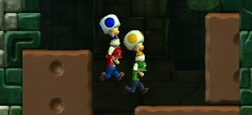
- HITCHING A RIDE. Lift a player and they can hitch a ride on your platforming train, so to speak. As long as they don't JUMP off they're free to travel along and even throw fire/ice balls.
- While carrying another player, you have the freedom to THROW or SPIN them. Throwing sends the player in an unbreakable tumble until landing or colliding with some other environmental factor. If the player you're carrying has a propeller powerup, when you SPIN you both fly upward together.
- After being lifted, the player on top can JUMP out of the hands of the carrier. This is an easy way to double jump and get a lot of height.
- The more common type of double jump is the FOOTSTOOL JUMP. Whenever you land on a player you can take advantage of their position and leap off of their head.
- SIMULTANEOUS GROUND POUND. When two or more players hit the ground from a ground pound at about the same time a shockwave is produced that has the power to destroy grounded enemies.
At the same time, we must consider all the ways players can work against the common good of the team. The following are NSMBWii's co-unter-op mechanics and design features.
- The GROUND POUND can be used to stun other players. If you get hit by another player in this way, you won't be able to recover until you hit the ground. That is, if there is ground beneath you. After getting hit you're highly vulnerable to pits and enemy elements.
- Freeze an enemy, pick it up, and toss it. Though the sliding ice block doesn't cause players damage after colliding with them, it does knock them over. This brief stun period is the same as getting hit by a GROUND POUND.
- If you GROUND POUND another player riding a Yoshi, you knock them off and instantly mount.
- We all know that a sliding Koopa shell can be very dangerous in a Mario game. We've learned to take care when sending shells careening about. In NSMBWii, even when you take care not to make things overly difficult for yourself, any one of the other players in a multiplayer game may decide to kick things off the wrong way.
- Player bodies are solid bodies in NSMBWii. So, if one player refuses to move or even moves against the flow, that player can become a significant obstacle.
- Outside of auto-scrolling levels, any player can push ahead through a level and drag the camera view behind them. If you can't keep up in the screen view, you'll be left behind.
- NSMBWii is great because up to four players can play together on the same screen at the same time. When players die, if they have additional lives they float back onto the screen in a bubble that can only be popped by another player. If you're the last player alive, you have the power to avoid bursting your friends out of their bubbles.
- One easy way to make things harder for your allies is to take more powerups than you need. Let's say 4 Mushrooms leap out of a ?-block. After grabbing one for yourself you continue to grab as many as you can before your allies can. The only thing you gain is a few extra thousand points and the ire of your allies.
- For more mischief you are free to grab and toss other players into danger or footstool them to keep them down.
Level 6) Organic Cooperation. Most of the co-op play in NSMBWii is organic. Players are free to assign roles, help each other, harm each other, wait for each other, and fight together. Aside from powerups like fire and ice balls, team attack is on. At all times, you must watch out for the position of your character, the level structures, enemies, and now your allies. Adding more players inherently changes the potential for cooperative play and the factors you must look out for to play effectively. This brings us to NSMBWii's (p)layered design.
(P)layered design is when the challenge of a level or level section changes organically with the addition of more players. This means that the challenge changes without any special code that alters the level elements or without going into a separate mode that adjusts game factors.
The core challenge of any 2D Mario platformer is created by forcing the player to move Mario around the screen and engage with gravity by JUMPing over structures and enemy elements. So, if adding a player to a Mario game inherently adds another structure/enemy element to the game, then the core challenge of the game is affected. Recognizing the dynamics of the core gameplay that additional players inherently affect is the first step in understanding a game's (p)layered design. Thus we need to distinguish which gameplay dynamics are also (p)layered dynamics and how the game designs around these dynamics.
Each player in NSMBWii contributes to the following (p)layered dynamics:
- Space. Player characters are solid bodies. Simply existing on the screen limits the available space for other players to move through.
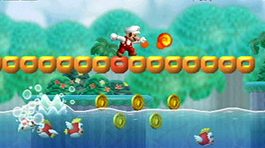
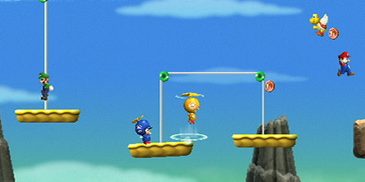
- Weight. This only comes into play with weight sensitive platforms and enemies. In the same way that each player character takes up space, they also individually weigh game elements down.
- parabeetles
- falling platforms (4-House, 9-2, 9-3)
- tipping stones (8-1)
- donut platforms (see image above)
- scales (see image above)
- Camera. The more players in a game the more likely it is that one player will advance the camera forward to the detriment of other players. This dynamic layers well with the (p)layered dynamic of space. The closer players stay together, the more they can intentionally or unintentionally get in each other's way. The more players spread out, the more likely the camera will catch players the lag behind.

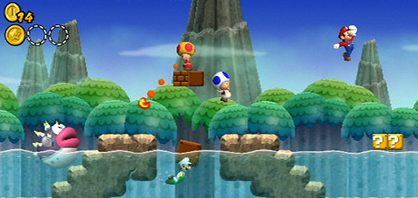
- Present Body. There are many enemy elements in NSMBWii that react to the a character's position. Just by adding more players to the game, these enemies become trickier than ever before some of which without changing their basic design from the original Super Mario Bros.
- Homing Bullet Bill, Homing Banzai Bill, Bullet Bill Cannons, Spikey Fish, lakitu, Chain Chomp, Fire Chomp, Monty Mole, Broozer, Fish Bones, Porcu-Puffers, Blooper, Cheep Cheep, Piranha Plants, Venus Fire Traps, Boo, Big Boo, Fire Snake, Swooper, Magikoopa, Bob-omb
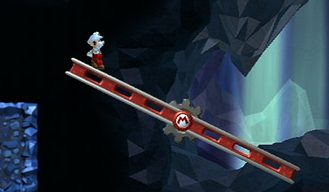

- Additionally, some platforms are specifically designed to respond to one player at a time. Whoever gets to one of these platforms first takes control. If that player leaves the platform, control is transferred to the next available player. This design doesn't necessarily force players to cooperate, but it does extend the influence one player can inherently have on the other players in the game.
So what does all of this mean to the design of NSMBWii? Basically, the newest addition to 2D Mario platforming design is singularly the most dynamic platform-ally-enemy element ever. Because of the (p)layered design, the more players in a game the harder and more interesting the game becomes.
Take a simplest feat like collecting powerups from ?-blocks for example. Since the original SMB, the same basic strategy has worked. Hit the block from beneath and either wait for the powerup to come down or JUMP up for it. In a co-op NSMBWii game, things get a lot more complicated. Firstly, a number of powerups come out of the ?-block equal to the number of players in the game. The types of powerups that come out are also depended on the powerup state of each player. The more normal or small players in the game, the more Mushrooms are released. The more Super players there are, the more fire flower, ice flower, penguin suits, and propeller hats come out.
Depending on how close all the players are to the ?-block, a few players may have to chase down their Mushrooms. Fire/Ice Flowers stay put where they fall while Penguin suits dance and Propeller hats hover then fly away. The combination of Mushroom and non-shroom powerups that are released from a ?-block create a range of different challenges. Grabbing the powerup you need and getting out of the way of the other powerups/players can be quite challenging. Due to the (p)layered dynamics of space, it's easier to get in each other's way than to coordinate actions. Of course, all of this is assuming that all the players want to share the powerups so that all benefit.
If any player is greedy, clumsy, or inconsiderate, they can take more than one powerup for themselves. Fighting for a run away Mushroom can be hard enough. But having to race/fight players leading up to the ?-block so that you can be in a better position to grab a powerup is a challenge on another level.
The multiplayer design of NSMBWii is so revolutionary for the 2D Mario platformers (and all games for that matter), that it far outshines the single player experience. As I have detailed in the other parts of this series, NSMBWii's design is the culmination of the design of many of its predecessors. Though its mechanics, structures, enemy, and secret design is the closest to NSMB, the large, open areas and generally sparse enemy arrangements make the emergent, counterpoint gameplay less frequent and less deep. In fact, the single player design of NSMBWii is good, but compared to the ultra tight and creative design of SMB3, it's missing a layer. That layer is the (p)layered layer. Like playing a Mario game without coins or enemies, playing NSMBWii solo doesn't complete the experience. NSMBWii has the potential to be the easiest and hardest Mario game ever.
By bringing players together in the same game, everyone can work together for the common good in ways that harken back to when I was a kid in preschool gathered around the lone object of entertainment.
 Platformer,
Platformer,  Super Mario Bros. in
Super Mario Bros. in  Co-op,
Co-op,  Dynamics,
Dynamics,  Genre,
Genre,  Level Design |
Level Design |  Permalink |
Permalink |  Print Article
Print Article 

Reader Comments (4)
The last two paragraphs basically capture my thoughts on NSMBWii. To be honest, I don't have much right to say a lot about the game because my first impressions were in the midst of being awake for 24+ hours and I was tired/delusional. Unfortunately, I was playing alone, and I think that was the problem. As soon as a couple of fellows joined me, the game suddenly took a turn for the better. In fact, we had a jolly good time!
I still think it's a major fault of the game that it's designed FOR multiple players. While this is great for multiplayer sessions, the single-player game should be (optionally at least) altered in some way to compensate. I'm sure platforms could be shrunk, and more enemies added, but I'm not sure if it's enough to make up for that "layer" that you can only see thru the lens of more people playing simultaneously.
So I do think it's great that it succeeded in delivering a fun multiplayer experience, but I think it leaves something to be desired in terms of offering a well-paced single player experience.
@ Toupee
Good comment.
To this day I haven't played NSMBWii through by myself. Sure, the game doesn't have the mutliplayer layer when played solo, but some people much prefer this. There are many who just can't handle when their friends become "bad buddies." They also don't have the skills to platform around their friends either.
There are the Toad rescue challenges that only come up for the single player. Furthermore, if you want more things to do solo, the super play videos are very inspiring. I'm not sure is there is anything the single player can do to "compensate."
Was just doing a re-read and happened to notice you spelt fact as 'fat' at the very end when talking about NSMBWii's single player. Just thought you might want to know.
@NathanS
Thanks. Fixed.